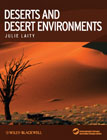
Taking a global perspective, this book provides a concise overview of drylands, including their physical, biological, temporal, and human components. INDICE: 1. Introduction: defining the desert system. 1.1 Defining the desert system. 1.2 Evolution of deserts. 1.3 Indices of aridity. 1.4 Desert surfaces. 1.5 Tectonically stable and unstable deserts. 1.6 Deserts of the past. 1.7Changing human perspectives on deserts. 2. Deserts of the world. 2.1 Introduction: the extent of global aridity. 2.2 Global deserts. 3. The climatic framework. 3.1 Introduction: classification of deserts by temperature. 3.2 Weather data. 3.3 Atmospheric controls: Surface boundary layer. 3.4 Temporal and spatial variability of climatic influences. 4. The hydrologic framework. 4.1 Introduction. 4.2 The water balance in deserts. 4.3 Water budgets. 4.4 Surface runoffand floods. 4.5 The chemical quality surface and soil of water. 4.6 Water resources. 4.7 Case study: the waters of the Tigris-Euphrates Basin and the impact of modern water management. 5. Lake systems: past and present. 5.1 Introduction to desert lakes. 5.2 Types of lakes. 5.3 Lakes of the global arid environment. 6. Weathering processes and hillslope systems. 6.1 Introduction. 6.2 Weathering. 6.3 Weathering forms. 6.4 Duricrusts. 6.5 Desert varnish. 6.6 Hillslope processes. 6.7. Composite surfaces (pediments). 7. Desert soils and geomorphic surfaces. 7.1 Introduction. 7.2 The nature of soils in arid and semiarid regions. 7.3 Soil description and classification. 7.4 Soil characteristics of arid regions. 7.5 Inorganic and biological soil crusts. 7.6 Spatial heterogeneity in soil properties and the ecohydrology of patterned vegetation zones. 7.7 Surface volume changes. 7.8 Surface types: hamada and stone pavements. 8. Wateras a geomorphic agent. 8.1 Introduction. 8.2 Groundwater sapping in slope andvalley development. 8.3 Piping processes in channel and slope evolution. 8.4 Fluvial processes. 8.5 Fluvial landforms. 9. Aeolian processes. 9.1 Introduction. 9.2 Near-surface flow. 9.3 Wind processes. 9.4 Landforms of Accumulation: Sand sheets, zibar, and sand stringers. 9.5 Landforms of Accumulation: Dunes. 9.6 Ripples. 10. Landforms of erosion and desert dust. 10.1 Introduction. 10.2Deflation features: desert depressions and pans. 10.3 Ventifacts. 10.4 Yardangs and ridge and swale systems. 10.5 Desert dust. 11. Plant communities and their geomorphic impacts. 11.1 Introduction: characteristics of desert ecosystems. 11.2 Adaptations to desert conditions. 11.3 Plant communities and ecotones.11.4 Succession in desert plant communities. 11.5 Dune communities. 11.6 Vegetation type and density and relationship to geomorphic processes. 12. Animal communities. 12.1 Introduction: environmental requirements. 12.2 Effects on geomorphic processes. 12.3 Hydrologic impacts. 12.4 Effects of the geomorphic activity of animals on plant communities. 13. Desertification and the human dimension. 13.1 Desertification: introduction and terminology. 13.2 Climate change and desertification. 13.3 Anthropogenic causes of desertification. 13.4 Water resources: a rural and urban problem. 13.5 Case study: The Aral Sea. 13.6 Discussion. References. Index
- ISBN: 978-1-5771-8033-3
- Editorial: John Wiley & Sons
- Encuadernacion: Rústica
- Páginas: 360
- Fecha Publicación: 24/10/2008
- Nº Volúmenes: 1
- Idioma: Inglés
